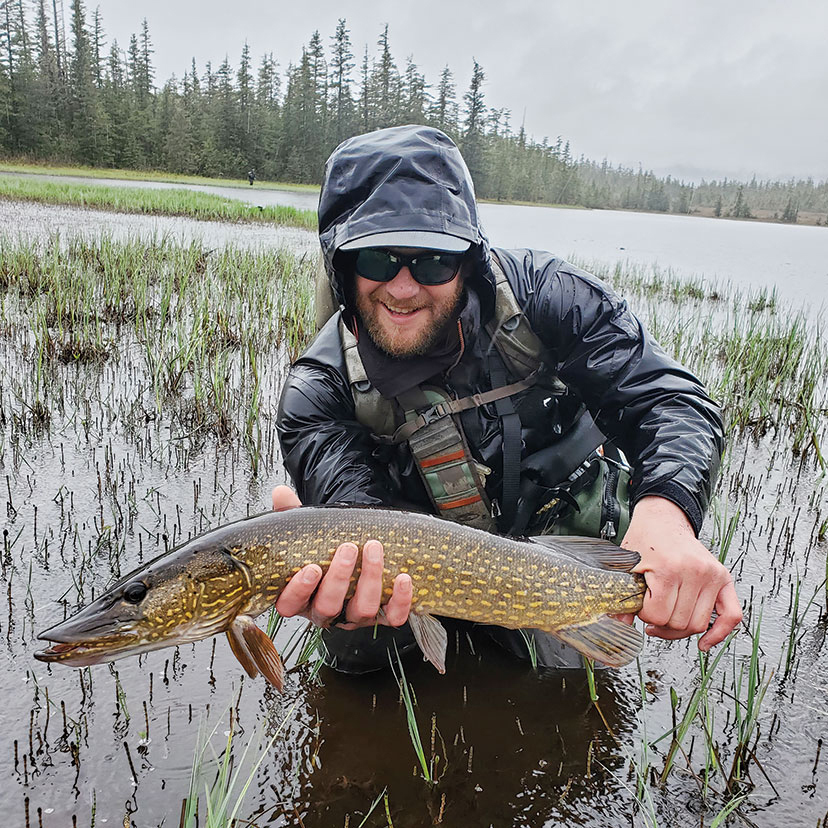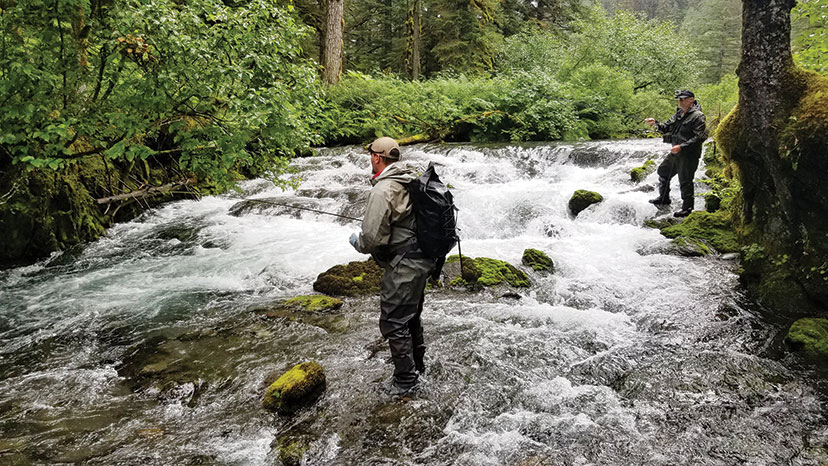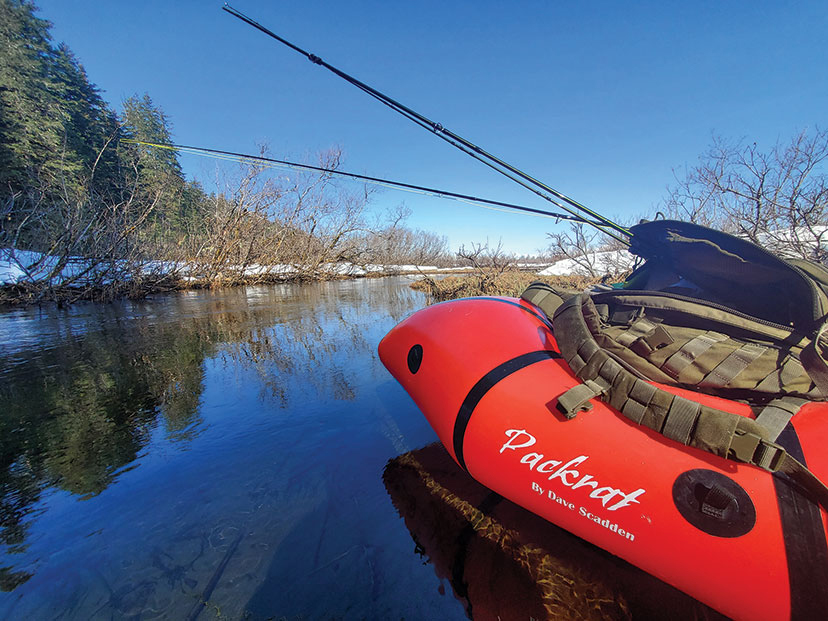Yakutat Road System Fishing Gems
Story and photos by Kraig Holdren
When Fish Alaska approached me about writing an article on Yakutat I was at a bit of an impasse. We all know the Situk is famous for its steelhead and who wouldn’t want to read about giant, chrome beasts in a crystal-clear fishery? But I wanted to talk about something else.
Yakutat has a fairly small, but extensive road system that crosses many small fisheries. Some you can just drive up to, others are hike-in, and others are fly-in only. This article is going to focus on what I consider the smaller road system “gems.” These spots are not necessarily something I personally would sell as a reason to come to Yakutat, but more of a way to burn a half day or perhaps you just want to get away from the crowds and try something different. Whether it be sea-run cutthroat, resident rainbow trout or what has got to be one of the only catch-and-release (by regulation) northern pike fisheries in Alaska, there is always something to do and somewhere to go. Depending upon your motivation to explore and your willingness to hike, all of them can be very lucrative and make for a great story to add to your Yakutat adventures.
Pot Belly Lake
 Our first stop when Yakutat road system fishing is a small lake about 27 miles out the Dangerous River Road. It’s a man-made lake, or at least partially, that drains into the Ahrnklin River. In the 10 years that I have fished this area, I have heard it called many names including Bean Belly Lake, Pot Belly Lake, Jelly Bean Pond or just, “that little puddle out past mile 26.” A small lake located on the left-hand side, you may have passed it many times while driving to Harlequin Lake. The lake itself is about eight acres in size and runs anywhere from 8- to 15 feet deep (it could be much deeper in places but I’ve never taken any electronics with me). The road access has been flooded by overzealous beavers and most passersby just keep on trucking without a thought about it.
Our first stop when Yakutat road system fishing is a small lake about 27 miles out the Dangerous River Road. It’s a man-made lake, or at least partially, that drains into the Ahrnklin River. In the 10 years that I have fished this area, I have heard it called many names including Bean Belly Lake, Pot Belly Lake, Jelly Bean Pond or just, “that little puddle out past mile 26.” A small lake located on the left-hand side, you may have passed it many times while driving to Harlequin Lake. The lake itself is about eight acres in size and runs anywhere from 8- to 15 feet deep (it could be much deeper in places but I’ve never taken any electronics with me). The road access has been flooded by overzealous beavers and most passersby just keep on trucking without a thought about it.
You’ll need a canoe, kayak, float tube or something to get you out into the lake itself as the banks are comprised of heavy tangles of willow and alder and the kind of mud that makes you wish you weren’t walking. Surprisingly, this lake is absolutely loaded with coastal cutthroat trout. A three- to four-weight fly rod or an ultralight spinning rod will give you two- to three hours of fun. The lake itself has one very small inlet on the south end and an outlet barricaded by a very impressive beaver dam to the north end. The bottom is mostly silty mud with tall, aqueous grasses growing from the hilly undulations below.
Tackle-wise, we have always fished small flies and spinners starting from the north end and essentially allowing the wind to drift us to the south while trolling our flies and spinners out the side of the boat. Each pass usually gives up two or three fish. Some days are far more productive than others and during periods of heavy rain the lake becomes muddy with visibility dropping to near zero, making it virtually unfishable.
The fish themselves are not any kind of lake monster with most topping out at 10- to 12 inches but there are still some impressive lunkers hiding among the weeds. Casting and stripping flies near the beaver dam at the north end has also produced some decent fish. When the winds are right the bugs are not an issue and enjoying the beautiful backdrop of the Wrangell-St. Elias Range while catching gorgeous little cutties makes for an incredible couple hours of play. This lake is small and not one that can handle much fishing pressure so if you plan to make a visit and there are cars parked at the lake, I would just move on and find somewhere else to play.
Pike Lake
 Our second spot is an interesting one and not one that I can really begin to describe how to find without wasting lots of time. It’s like any other directions you get in Alaska: “Find that one big rock, cross the meadow then traverse the beaver dam….” It is actually a very short hike, but one that does require waders, a keen sense of direction and a hell of a good brand of bug spray. Nestled about 600 yards across a meadow lies a series of boggy lakes that are chock full of native northern pike.
Our second spot is an interesting one and not one that I can really begin to describe how to find without wasting lots of time. It’s like any other directions you get in Alaska: “Find that one big rock, cross the meadow then traverse the beaver dam….” It is actually a very short hike, but one that does require waders, a keen sense of direction and a hell of a good brand of bug spray. Nestled about 600 yards across a meadow lies a series of boggy lakes that are chock full of native northern pike.
In many fisheries in Alaska, pike are not native and were introduced by human intervention. Not these babies; they have been there since the last ice age and are a true, native population. Because of this, the fishery is 100% catch-and-release! I thought it was a typo when I first read it in the regulations but to my surprise it was not. A pamphlet describing how to find the lake as well as how special these fish are can be found at the local Yakutat Forest Service Ranger Station.
Once you find the lake, I think you will be quite surprised at how much fun this fishery is. The lake itself is about 13 acres and is surrounded by meadows and scrubby spruce with the southern edge covered in old growth spruce and hemlock along a high moraine of rock. Surrounding the lake, like many here in Yakutat, is a thick blanket of water-born grasses and lily pads. There is an outlet to the southwest and the inlet is on the opposite side to the northeast. The outlet and inlets are great fun to fish and depending on the time of year can be extremely productive areas to fish. This is a great place to bring those weedless lures, but while there we fish almost exclusively topwater. Small rubber frogs and ducks, smaller glide baits (early in the season before the lilies get too thick) and for those flyfishing, there is no limit to the amount of mouse takes you can get.
Most of the fish in this lake are what most would consider hammer handles and smaller, but I’ve seen fish as big as 36 inches hooked in this lake system. For the truly adventurous, this lake is connected to several others further into the wilderness that are also chock full of pike with nowhere to go. Steel leaders, or at least running 25-pound-test mono, will keep your flies or lures attached as these toothy fish will cut through your line faster than you can set the hook. Don’t waste your time casting as far as you can as more than 90% of your takes will be within 10 feet of the bank. The bugs here can be voracious, and you’ll likely see plenty of bear and moose sign, so keep your ears open and let them know you are around.
Mountain Stream
 Stop #3 is by far one of my favorite trips and one of my least favorite. It’s not for everyone, but if you’ve got an itch for catching native rainbow trout while you’re in Alaska, then this is the trip for you. While the Situk River does host local rainbows, they are more of an incidental catch here and there; to my guides, landing a decent rainbow in the Situk is like catching a great white buffalo!
Stop #3 is by far one of my favorite trips and one of my least favorite. It’s not for everyone, but if you’ve got an itch for catching native rainbow trout while you’re in Alaska, then this is the trip for you. While the Situk River does host local rainbows, they are more of an incidental catch here and there; to my guides, landing a decent rainbow in the Situk is like catching a great white buffalo!
Mountain Stream is a small, 2.5- to 3-mile-long creek with a chunky and slimy bottom, giant log jams, and snakes down the mountain through some of the prettiest country you’ll ever see. I always tell people I feel like I’m walking through Jurassic Park. It’s filled with giant spruce and hemlock with Devil’s club and willow so tall you cannot see through it.
The round-trip hike is the better part of 10 miles, thus the least favorite part. It hosts some of the best rainbow fishing I have ever experienced in Alaska. Now to be fair, the fish aren’t all huge, in fact many are what you would consider small when you think of Alaskan rainbows, but I would say a 12- to 14-inch average is plenty big for me and my 5-weight fly rod. Small, weighted streamers and leeches on a light floating line has always been my go-to for this creek. The action is continuous as this little creek sees almost no pressure, year-round.
Make no mistake, you are in bear country up here, and this place will have the hairs on your neck standing up almost the whole time, knowing they could be anywhere.
From the top at the lake, there is a beautiful, small waterfall with a long, wide plunge pool at the bottom usually filled with spawning sockeye, king salmon and steelhead, but we’re not here to harass them. They’ve worked damn hard to make it there and deserve a rest before the rigors of spawning inevitably kills them off as part of their natural life cycle.
Working your way down the creek, just about any corner, pocket or woody spot will reward you with one or two fish. I do recommend anytime anyone ventures to this area to notify someone of your whereabouts including what time you expect to be out of the woods as it is easy to get turned around and one can end up in the wrong place without knowing it. At the outlet of Mountain Stream is a small delta of shifting sands and gravel before it drops into the depths of Situk Lake where a heavy sink-tip and a long cast will reward you with more fish to end the day.
During late July through about mid-August, you can also find one of Alaska’s favorites (red salmon) who are still working their way to their spawning grounds. Many of the fish at this point have turned red but many still are bright, and I have, on multiple occasions, caught fresh sockeye with sea-lice adorning their flanks.
For those who wish to make a multi-day trip there is a cabin at Situk Lake where the Situk Lake Trail terminates and the Mountain Stream Trail begins. There is also a canoe, and the cabin can be reserved through the Forest Service at recreation.gov. Mountain Lake and Situk Lake themselves can both be lucrative spots to fish and with a packraft or use of the canoe, can bring endless fun for those who feel like they need a real escape from town or the Situk River.
Tawah Creek
 Stop #4 to experience Yakutat road system fishing is not so much a secret spot nor does it require any kind of death march up the side of a mountain, however in my honest opinion it’s one of the most underrated fisheries in Yakutat. I’m talking, of course, about Tawah Creek. I could spend hours talking about this little “ditch,” but I’ll spare all the pomp and circumstance and just glaze over the finer points.
Stop #4 to experience Yakutat road system fishing is not so much a secret spot nor does it require any kind of death march up the side of a mountain, however in my honest opinion it’s one of the most underrated fisheries in Yakutat. I’m talking, of course, about Tawah Creek. I could spend hours talking about this little “ditch,” but I’ll spare all the pomp and circumstance and just glaze over the finer points.
Running north to south beginning at Summit Lake, which is partially viewable from Cannon Beach, this narrow, windy stream runs parallel to Cannon Beach on the opposite side of the trees for about 5.5 miles before it joins the Lost River.
Tawah winds its way lazily through marshy bog, lush scrub meadows and old-growth spruce forest. All a person needs is a packraft and a four- to five-weight fly rod, a few streamers and some mice patterns to make this an unforgettable day of fishing. From early June through September, this creek hosts a very large run of sea-run cutthroat and later in the summer it gets a sizable run of both pink and silver salmon.
Tawah Creek has several access points, well-defined trails with heavy plastic matting to help keep you on the trail and out of the mud so a boat isn’t always necessary to have a great time. There are multiple drainages coming from the meadows which create amazing spawning habitat for salmon so the cutts are there to gorge themselves on eggs and fry before they migrate back to the salt for the winter. The area is also host to many moose and bear, and one should pay close attention as the banks in many places are very tall and the grasses taller. I’ve had several less than enjoyable instances of being followed down river by bear and moose; of course, they were just escorting me out of their private space.
Cutbanks, deep pockets and slough outlets seem to provide the most action, however there are some gorgeous flats with stumps and logs that have plenty of fish playing hide-and-seek with the fry making their way to the ocean. Using a four- to five-weight fly rod is definitely going to be the big winner here, but don’t be surprised as you may find a few trophy-sized cutts hiding deep under the grass banks and having one take a mouse off the top will be enough to feel accomplished whether he sticks or not.
If salmon are on your agenda, then maybe bump that rod size up a bit and make sure to bring a stringer as Tawah hosts some of the best big-fish genetics when it comes to silver salmon. The action can be prolific from early September through early October.
There are several other places to enjoy Yakutat road system fishing and as I mentioned before, I could spend all day writing about them. But these four are my absolute favorite ways to burn a day when I’ve had enough of the Situk. There are many local resources to help find these places and maps to many can be found through the USFS ranger station. When it comes to the trout here, I ask that you fish barbless hooks whenever possible and practice catch-and-release as there are plenty of salmon, halibut and other delicacies to be had in the Yakutat area. I hope you will enjoy these places as much as I do. Remember to pack it in and pack it out and as always, tight lines.
Kraig Holdren is the General Manager of Yakutat Lodge, and an avid angler and hunter. He’s guided on the Situk since 2015, is a lifelong Alaskan and lives in Yakutat year-round.





